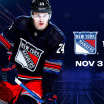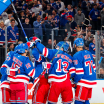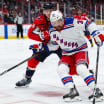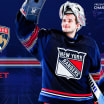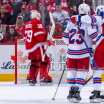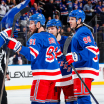SPECIAL TICKET PACKAGE: Join us on 12/2 for an exclusive pre-game meet & greet featuring the GAG Line and then witness Rangers history when Vic Hadfield's #11 is raised to the rafters at The Garden. CLICK HERE TO GET TICKETS »
Vic Hadfield describes himself this way: "I am a Ranger through and through."
He was the captain of the Rangers in the 1970s, the first 50-goal scorer in the history of the franchise, the ultimate teammate - and on Dec. 2, his No. 11 will take its place among the Rangers legends in the Garden rafters.
NYRangers.com will present 11 of the great moments of Hadfield's career, 11 snapshots of the Blueshirts' legendary left winger, 11 for No. 11 - counting down to the celebration of Vic Hadfield Night presented by Budweiser before the Blueshirts take on the Winnipeg Jets on Dec. 2 at Madison Square Garden.
When the Rangers drafted Vic Hadfield from Chicago in the 1961 Intra-League Draft, they knew they were getting a player who could command respect on the ice. They never could have known they were selecting a future captain.
But the just as the Rangers were emerging from a lean decade of the 1960s into a perennial Stanley Cup contender in an expanded League, Hadfield was emerging from rugged role player into one of the team's stars and leading goal scorers. He had scored 13 points (with eight goals) in the 1971 playoffs, setting a Ranger record that he himself would break in '72. The Rangers had given Bobby Hull and the Blackhawks all they could handle in the '71 NHL semifinal, forcing a seventh game on Pete Stemkowski's triple-overtime goal at Madison Square Garden before coming up short three nights later at Chicago Stadium.
In the summer of 1971, Emile Francis was getting the Rangers reloaded for another run at the Stanley Cup. As part of his offseason maneuvering, that May he had struck a deal with the North Stars that sent the Rangers' captain, Bob Nevin, to Minnesota, for future considerations (which turned into Bobby Rousseau).
When Francis was preparing to travel to Montreal for the NHL Amateur Draft that June, he asked Hadfield to tag along.
"I just thought it'd be interesting for me to go to the draft, see what they were going to do, whatever," Hadfield told NYRangers.com. "I had no idea Emile had any other kind of plan."
Vic Hadfield Legendary Moments No. 8: The Captaincy



